
ETF and ETP Assets Have Surpassed or Are Posed to Surpass Assets Invested in Hedge Funds
A hedge fund is a fund that can take both long and short positions, use arbitrage, buy and sell undervalued securities, trade futures and options, and invest in almost any asset class or market where it sees opportunities with a goal of delivering absolute returns while minimizing risk and volatility and preserving capital. The first hedge fund was launched in 1949 or 64 years ago offering a long/short strategy. Hedge funds operate in 8 broad strategies: long/short, event driven, multi-strategy, global macro, CTA, distressed, and equity market neutral.
Since the end of September 2013 hedge funds in the US have been allowed to advertise that they are looking to raise assets. Investors in hedge funds have historically been predominantly institutional investors and some high net worth “accredited investors” that have a net worth of more than $1 million (not counting their primary residence) or have an income greater than $200,000 in each of the prior two years. The ability to advertise does not mean that they can now accept investments from financial advisors and retail investors.
ETFs and ETPs unlike hedge funds are unique in that they are a very democratic investment product allowing and being used by institutional investors, financial advisors and retail investors to have access to the same set of products at the same asset weighted annual cost of 33 basis points for ETFs/ETPs (source ETFGI) with a minimum investment that is often just one share with a value of typically less than $200.
The first ETFs were launched in Canada twenty-three years ago in 1990. At the end of Q3 2013, the global ETF/ETP industry had 4,982 ETFs/ETPs, with 10,019 listings, a record level of assets of $2.224 trillion, from 212 providers on 57 exchanges (source ETFGI).
Although hedge funds have existed for nearly triple the number of years that ETFs/ETPs have we see that the assets in ETFs/ETPs at $2.224 trillion have surpassed the assets in hedge funds or are on course to do so soon depending on which source of hedge fund data you use. At the end of Q3 2013 Eurekahedge reported that there was $1.91 trillion invested in 8,500 hedge funds which they state was just 2% below their historic peak, BarclayHedge reported that there was $2.0 trillion invested in 4,922 hedge funds and HFR another firm which creates research and offers a database on the global hedge fund industry reported a new record level of $2.5 trillion in assets in 8,201 hedge funds which is significantly higher than the than the prior record of $1.8 trillion in 2007. (Each firm was asked to explain the reasons for the significant difference – over $500 billion in reported assets - they all state that they cover the universe of global single manager hedge funds and have a policy of not commenting on other firms data.)
In 2012 hedge fund gathered $34.4 billion (source HFR) in net new assets which is just 12% of the $264.98 billion gathered by ETFs/ETPs. Year to date through Q3 2013 ETFs/ETPs have gathered $202.16 billion in net new assets while hedge funds have only gathered $53.22 billion in net new assets (source HFR). Assets invested in ETFs/ETPs have been growing at 29.6% compounded annual growth rate over the past 10 years which is must faster than the growth rate in assets invested in hedge funds.
Most new money goes into the largest hedge funds those that have assets of at least $50 million and typically larger. The fees charged by the majority of hedge funds are 2% of assets and 20% of the profits. The performance of many hedge fund strategies and many hedge funds has not been very good over the past few years. At the end of October 2013 the average hedge fund has made 5 per cent on its investments so far this year, according to Eurekahedge, compared with a return of 16 per cent for the MSCI world index and 24 per cent for the S&P 500. With the positive performance of equity markets many investors have been happy with index returns. This situation has benefited ETFs/ETPs which offer an enormous tool box of index exposures to various markets and asset classes including hedge fund indices and active ETFs. The asset weighted annual cost for ETFs/ETPs is 33 basis points or one third of a percent (source ETFGI global ETF and ETP insight report for Q3 2013).
With approx. 10,000 hedge funds we see that the average size of hedge funds is significantly smaller than the average size of ETFs/ETPs with approx. 5,000 products. Hedge funds like ETFs/ETPs have seen a significant number of new product launches and also product closures.
We expect the assets in ETFs/ETPs to continue to grow at a faster rate than hedge funds.
